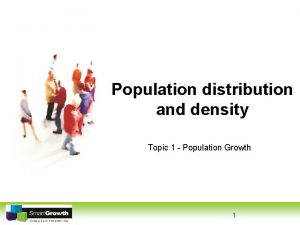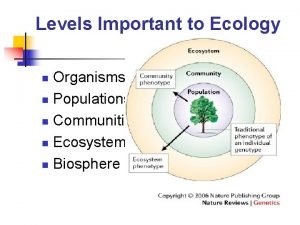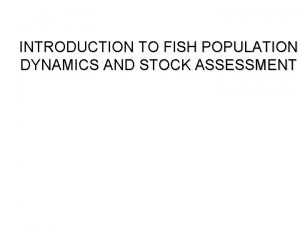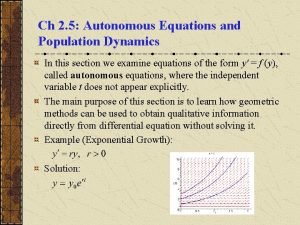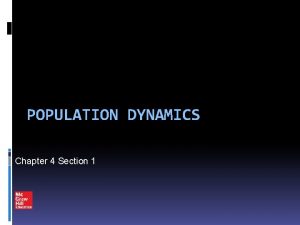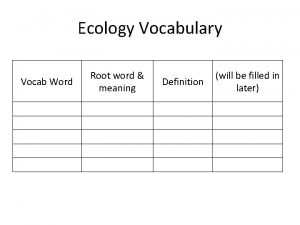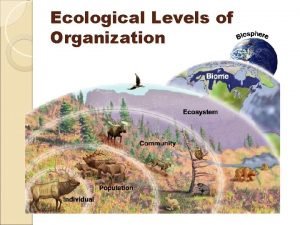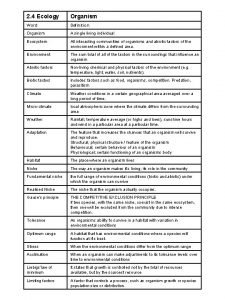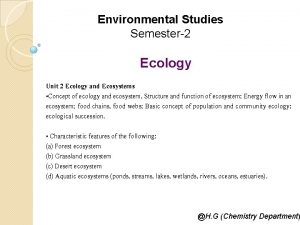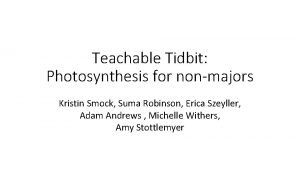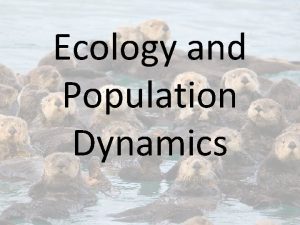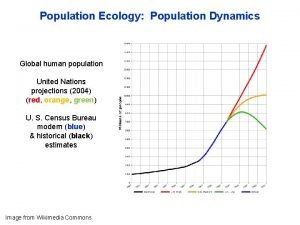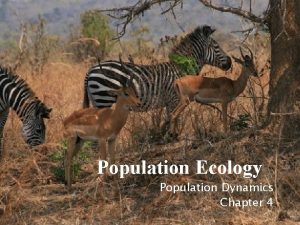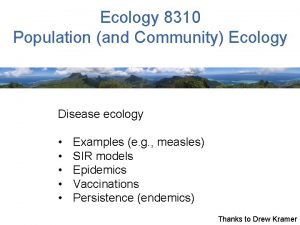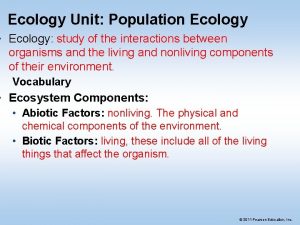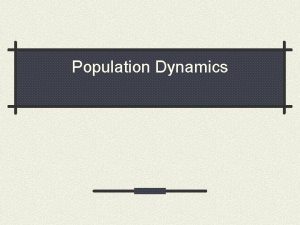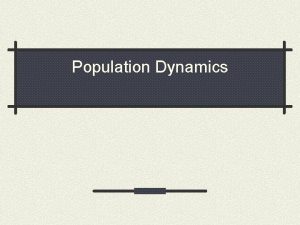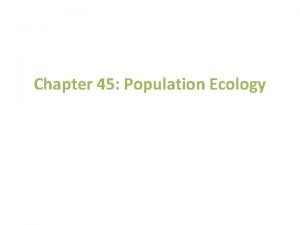1 30 17 Population Ecology Population Dynamics Population



































- Slides: 35

1 -30 -17

Population Ecology

Population Dynamics • Population: • All the individuals of a species that live together in an area • Demography: • The statistical study of populations, allows predictions to be made about how a population will change

Population Dynamics • Three Key Features of Populations 1. Size 2. Density 3. Dispersion

Three Key Features of Populations Size: number of individuals in an area

Three Key Features of Populations • Growth Rate: • Birth Rate (natality) - Death Rate (mortality) • How many individuals are born vs. how many die • Birth rate (b) − death rate (d) = rate of natural increase (r)


Three Key Features of Populations Density: measurement of population per unit area or unit volume Pop. Density = # of individuals ÷ unit of space

How Do You Affect Density? 1. Immigration: movement of individuals into a population 2. Emigration: movement of individuals out of a population

3. Density-dependent factors: Biotic factors in the environment that have an increasing effect as population size increases (disease, competition, parasites) 4. Density-independent factors: Abiotic factors in the environment that affect populations regardless of their density (temperature, weather)

Population Dispersion

Three Key Features of Populations • Dispersion: describes the spacing of organisms relative to each other 1. Clumped 2. Uniform 3. Random

How Are Populations Measured? • Population density = number of individuals in a given area or volume • Count all the individuals in a population • Estimate by sampling • Mark-Recapture Method

How Do Populations Grow? • Idealized models describe two kinds of population growth: 1. Exponential Growth 2. Logistic Growth

Carrying Capacity • Carrying Capacity (k): • The maximum population size that can be supported by the available resources • There can only be as many organisms as the environmental resources can support

Exponential Growth Curve Figure 35. 3 A

Logistic Growth Curve

Factors Limiting Growth Rate • Declining birth rate or increasing death rate are caused by several factors including: 1. Limited food supply 2. The buildup of toxic wastes 3. Increased disease 4. Predation

Reproductive Strategies • R Strategists § Short life span § Small body size § Reproduce quickly § Have many young § Little parental care § Ex: cockroaches, weeds, bacteria

Reproductive Strategies • K Strategists § Long life span § Large body size § Reproduce slowly § Have few young § Provides parental care § Ex: humans, elephants

1. What type of growth model does this graph show?

2. If angelfish produce hundreds of young several times a year, which statement below is true? A. Angelfish have a k-strategy reproductive pattern. B. Angelfish have a r-strategy reproductive pattern

3. If an aquarium holds 80 L of water and contains 170 guppies, what is the approximate density of the guppy population?

4. Which is a densityindependent factor? A. B. C. D. A severe drought An intestinal parasite A fatal virus Severe overcrowding

1 -31 -17

Why is the lifespan of this finch with an eye disease most likely reduced? A. The bird B. The bird C. The bird D. The bird change. cannot mate. cannot find food or water. spreads the disease to others. cannot survive a temperature

Which is a possible reason for the relative quick spread of the shown disease? A. An abiotic factor B. A decrease food supply C. Increase in population density D. Increased immunity

What is the reproductive strategy of the animal in the photo. Explain your answer.

The Human Population • Doubled three times in the last three centuries • About 7. 3 billion and may reach 9. 3 billion by the year 2050 • Improved health and technology have lowered death rates

History of the Human Population

Human Population Growth • J curve growth • Grows at a rate of about 80 million yearly • r =1. 3% • Why doesn’t environmental resistance take effect? • Altering their environment • Technological advances • The cultural revolution • The agricultural revolution • The industrial-medical revolution

Trends in Human Population Growth • The change in population from high birth rate and death rates to low birth rates and death rates is called demographic transition. • Zero population growth occurs when births plus immigration equals deaths plus emigration.

Age Distribution • Distribution of males and females in each age group of a population 1. Pre-reproduction (before 20 yrs old) 2. Reproduction( 20 -44 yrs old) 3. Post-reproduction ( 45 and up) Used to predict future population


What is the dispersion pattern of herding animals, birds that flock together, and fish that form schools? A. Clumped B. Random C. Uniform D. Unpredictable
 Chapter 4 section 1 population dynamics answer key
Chapter 4 section 1 population dynamics answer key Population ecology section 1 population dynamics
Population ecology section 1 population dynamics Population ecology section 1 population dynamics
Population ecology section 1 population dynamics Population ecology section 1 population dynamics
Population ecology section 1 population dynamics Population distribution
Population distribution Ecology
Ecology Logistic growth ecology definition
Logistic growth ecology definition Population characteristics ecology
Population characteristics ecology Concept 3 population ecology
Concept 3 population ecology Population ecology
Population ecology Lynx and hare relationship
Lynx and hare relationship Define exponential population growth
Define exponential population growth Ideal population growth curve
Ideal population growth curve Chapter 53 population ecology
Chapter 53 population ecology Chapter 53 population ecology
Chapter 53 population ecology Chapter 53 population ecology
Chapter 53 population ecology Fig 52
Fig 52 Population definition ecology
Population definition ecology Equilibrial life history
Equilibrial life history Chapter 4 section 1 population dynamics answer key
Chapter 4 section 1 population dynamics answer key What is uniform dispersion
What is uniform dispersion Population vs community ecology
Population vs community ecology Galapagos
Galapagos Fish population dynamics and stock assessment
Fish population dynamics and stock assessment Autonomous equations and population dynamics
Autonomous equations and population dynamics Study guide chapter 4 section 1 population dynamics
Study guide chapter 4 section 1 population dynamics Human ecology
Human ecology Vocabulary ecology
Vocabulary ecology Ecology foldable
Ecology foldable Definition of organism in ecology
Definition of organism in ecology Difference between ecosystem and ecology
Difference between ecosystem and ecology Ecosystem ecology
Ecosystem ecology Ecology part 1
Ecology part 1 Chapter 2 principles of ecology answers
Chapter 2 principles of ecology answers Human ecology
Human ecology Mind map about media and information literacy
Mind map about media and information literacy




